HIPAA Compliance Checklist for 2025

You’ve probably seen it happen. Marketing spins up an Asana project for a campaign, product joins in to “stay aligned,” then HR adds a workspace for employee onboarding, and suddenly, everyone’s in Asana.
Then, a few months later, finance opens the invoice and goes, “Wait, since when do we have 80 paid seats?” Someone checks the usage report and half those seats haven’t been active in weeks. But no one wants to remove them because “what if they need access later?”
According to NexThink, companies waste nearly 35% of their spend on collaboration apps due to idle seats, and Asana is almost always on that list. One “temporary” license turns into three, and before you know it, your project tracker is quietly draining the budget.
That’s where CloudEagle.ai comes in. It gives you that missing visibility: who’s using what, where licenses overlap, and what can safely be reclaimed. It doesn’t interrupt how teams work; it just makes sure the cost matches the value.
TL;DR
- Asana’s easy collaboration model often leads to uncontrolled seat growth such as campaign seats, cloned workspaces, and temporary users that stay paid.
- Inactive users, guest accounts, and duplicated boards quietly inflate budgets, turning one-time projects into recurring costs.
- Teams rely on spreadsheets that rarely match reality, creating false confidence and missed opportunities for optimization.
- Renewals arrive before finance catches the waste, locking in unneeded seats and higher-tier upgrades.
- CloudEagle.ai centralizes visibility, tracks usage in real time, automates reclamation, and optimizes renewals, keeping Asana costs predictable and efficient.
“We Added Seats For That Campaign, Did Someone Cancel It?”
It starts with a quick Slack message: “We just need five more Asana seats, it’s for the launch sprint.” Nobody argues. The campaign’s urgent, so approvals are automatic, and budgets have a little flexibility. Five seats turn into eight. The launch ends, but nobody remembers to trim things back.
From the team’s perspective:
It feels harmless. Those seats might be useful again next quarter, so why cancel now? Everyone’s heads-down in new projects, and admin cleanup isn’t exactly thrilling work. As long as Asana keeps running, it doesn’t feel like a problem.
From finance or IT’s perspective:
It’s a recurring headache. They see charges stacking for users no one can identify. The spreadsheets don’t match the invoices, and every attempt to “optimize” risks breaking something still in use.
The result? Months pass. Those campaign seats keep renewing automatically, billed as part of the standard plan. No alarms go off, no alerts appear, just another silent drip of spend in the background.
By the time anyone asks, “Wait, did we ever cancel those extra seats?”, the answer usually comes with a sigh and a shrug: “Probably not.”
The Quiet Theft: Licenses Vanish Into Everyday Workflows
It’s never one big decision that drains your SaaS budget, it’s a hundred small ones. A designer joins a temporary sprint, someone adds them to a board “just in case,” and suddenly there’s another paid seat nobody thinks twice about.
1. Guests Who Turn Into Billable Users Overnight
You know that moment when a freelancer joins a board for a week, and everyone thinks, “No worries, it’s temporary”? Fast forward a month, and that guest is quietly counted as a full paid user. Suddenly, your “tiny add-on” is a line item sneaking into your invoice.
- The Sneaky Guest: Added for a short sprint, now billed like a regular team member.
- The Forgotten Contributor: Project ends, but the account stays active, no one notices.
- Automatic Upgrade Trap: Asana quietly tallies them in the paid user count.
- The Silent Multiplier: One overlooked guest across several projects can quickly snowball.
It’s easy to miss because everyone’s focused on deadlines and deliverables. Guest accounts feel harmless until finance opens the invoice.
- Invoice Surprise: That single guest might cost $12–$15 a month.
- Compounding Effect: Multiple boards, multiple freelancers, suddenly it’s hundreds of dollars unaccounted for.
- Vanishing Visibility: Without central tracking, these users quietly inflate month after month.
A report from TechRepublic shows that organizations waste around 30% of their software spend on unused or mismanaged licenses, proving just how quickly these “temporary” guests turn into budget leaks.
2. Teams That Clone Workspaces Instead Of Sharing
Ever notice how two marketing squads end up with almost identical workspaces? One decides to “just copy this board” because it’s faster than asking the other team for access. It feels easy, until you realize each cloned workspace carries its own license count.
- The Copycat Workspace: Same tasks, same templates, now double the license cost.
- Redundant Admins: Two admins managing essentially the same projects, but both are billed.
- Data Fragmentation: Notes, attachments, and updates split across clones, making tracking a nightmare.
It’s tempting to clone instead of coordinate. Deadlines are tight, priorities shift, and no one wants to wait for access approvals. But what looks like efficiency quietly drives up spend.
3. Small Requests That Compound Into A Line Item
Ever had someone ask for just one extra Asana seat “for a quick task”? You approve it, and everyone moves on. Then another team does the same, and soon enough, it feels like a tiny ripple in a calm pond, but ripples add up.
Weeks pass, and those small requests quietly stack into a noticeable line item on your invoice. Teams rarely track these incremental seats, so the spend grows while no one really notices.
From IT’s side, they don’t focus too much. From finance’s side, it starts looking like a mini-budget mystery. By the time renewal season arrives, all those little “just one more” approvals suddenly feel like a very expensive habit.
When Spreadsheets Lie And Reality Speaks
You know that feeling when your carefully maintained Asana license spreadsheet says everything is under control. But then renewal hits, and the numbers don’t add up? Spreadsheets give a comforting illusion of order, yet reality often tells a different story, even with an agency backing you up.
1. Reports Claim Usage; People Know Different
You glance at the Asana dashboard, and everything looks perfect. Every license accounted for, every seat active. But you’ve probably heard whispers in the team, some seats haven’t been touched in months.
Team Thinks This Way:
“Yeah, this seat is assigned to me, but I haven’t actually used it since the last project.” Employees know which licenses are truly in use, but they rarely shout it out, and nobody tracks the redundant SaaS applications formally.
IT Thinks This Way:
The numbers don’t lie or so they think. Reports claim full utilization, so budgets are built on that illusion. Renewal forecasts feel safe, until reality shows up.
Managers Think This Way:
Everything appears to run smoothly, but idle licenses quietly inflate costs. Decisions about upgrades or adding more seats are made on a shaky foundation, leaving dollars wasted unnoticed.
By the time someone questions it, that “perfect utilization” on paper has quietly cost the company a chunk of its quarterly budget.
2. “Looks Normal” Until The Renewal Email Arrives
You’ve got the dashboard pulled up. Everything says green. License counts, user log‑ins, project status. You lean back thinking you’ve got this under control. Then… the renewal email lands and your budget does a double take.
- The “Just Add One More” Seat: “We’ll only need it this quarter,” someone says. The quarter ends, the seat stays.
- The “Surprise Add‑On” Upgrade: A team needed extra features mid‑campaign. Approval was fast, tracking was slow.
- The “Hidden Renewal” Line Item: A card gets charged, unnoticed, while everyone keeps working.
- The “Invoice Face‑Palm”: You realize that the cost grew quietly, and by then it’s baked into next year’s budget.
As Ben Horowitz once said,
“If you’re going to be successful you’re going to have to do hard things, and people will judge you on how you deal with them.”
In this case the “hard thing” isn’t a complex project but noticing that “everything’s fine” might just be the calm before a budget storm.
- The Budget Drift: Small costs sneak past until they become big ones.
- The Governance Gap: Teams moved fast, spent fast, now finance has to untangle what got done and what got paid.
- The Feature‑Trap: More seats + upgraded features ≠ more value, unless usage matches.
When renewal emails become a surprise rather than a checkpoint, that’s the signal: visibility is missing. And that’s where the real cloud cost optimization trick lives.
3. The Data Lag That Costs You a Quarter’s Budget
Sometimes, your reports feel like they’re from the future, showing usage numbers that look perfect today, but the reality in the teams is completely different. By the time dashboards reconcile, it’s often too late to act without affecting next quarter’s budget.
- Delayed Usage Tracking: A license may show active on the report, but the user hasn’t logged in for months.
- Quarterly Reconciliation Headaches: Finance teams scramble to align the numbers, leading to rushed decisions and budget reallocations.
By the time the data catches up, that “small discrepancy” has snowballed into a sizeable chunk of wasted spend. Teams work thinking everything’s fine, while the finance team is left chasing shadow IT, trying to rationalize what’s already been paid.
- Missed Opportunities for Optimization: Slow data means slow decisions.
- Invisible License Hoarding: Seats get renewed automatically even if unused.
- Stress During Audits: When real numbers finally surface, the scramble can be chaotic.
CloudEagle in One Line: Find Waste, Fix It Without Drama
Managing Asana licenses scattered across multiple SSO portals, usage dashboards, and billing records can quickly become overwhelming. Traditional spreadsheets may only capture the most visible apps, leaving many licenses untracked and overlooked.
This disjointed approach leads to avoidable overspending, SaaS compliance concerns, and missed chances to optimize usage.

CloudEagle.ai provides a unified, real-time view of every Asana license and related spend. It automates monitoring, usage insights, and renewal workflows, turning a previously manual and inconsistent process into a structured, intelligent, and data-guided system.
1. Direct Asana Admin Console Sync
Manually managing Asana licenses is slow, prone to mistakes, and draining for IT teams. Building tracking spreadsheets can take weeks, and by the time they are assembled, the information is already outdated. This leaves teams without accurate visibility into subscriptions, usage levels, or Asana plan details.
Current Process
Most organizations rely on spreadsheets and scattered tools to monitor renewals, license allocations, and user activity. This creates disconnected data sources, and updates often become stale before anyone evaluates them.
Pain Points
Manual data entry and delayed updates introduce inaccuracies and blind spots in software spend oversight. IT and finance teams are left without dependable, real-time visibility.
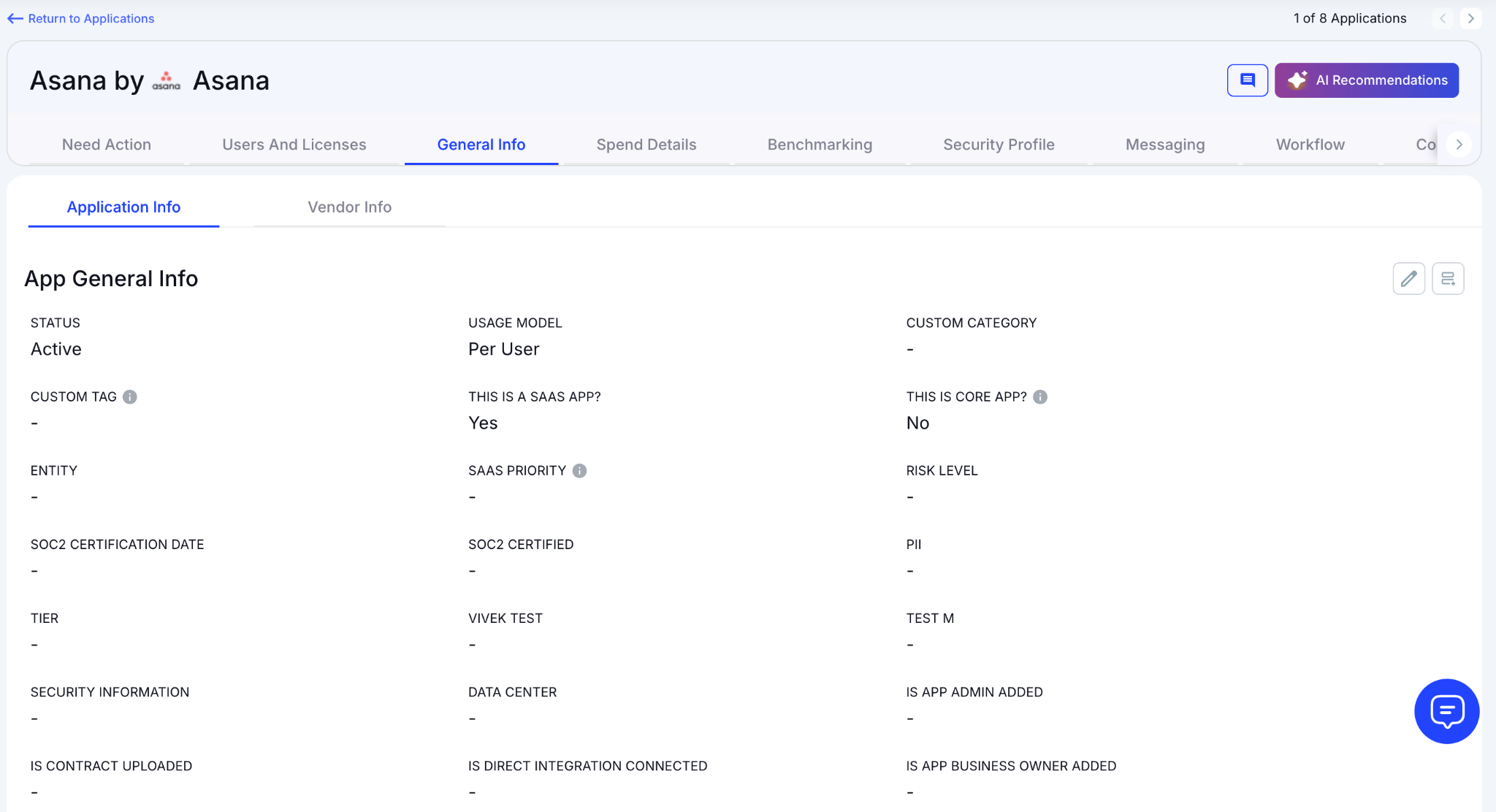
How We Do It
CloudEagle.ai consolidates vendor spend, usage trends, and AI-powered metadata extraction from every connected system in real time. Renewal timelines, cost summaries, and active usage appear together for quick, confident analysis.
Why We Are Better
Implementation requires only a few days. With 500+ native integrations and automated metadata extraction, CloudEagle.ai centralizes all license data in one place, ensuring it stays consistent, trustworthy, and continuously up to date.
2. Live Usage Insights & Shadow IT Visibility
Without centralized governance, Asana license usage and overlapping tools can quickly get out of hand. Shadow IT often slips under the radar, making it difficult for IT teams to identify redundant applications scattered across teams.
Current Process
Teams may purchase duplicate tools through corporate cards or sign up for free trials that later convert into billable subscriptions. Manually uncovering these overlaps across departments is incredibly challenging.
Pain Points
Shadow IT creates unmonitored Asana spend and introduces avoidable SaaS security risks. Trying to locate duplicate applications by hand is time-consuming and often fails to surface all redundancies.

How We Do It
CloudEagle.ai continuously scans for duplicate and overlapping applications using AI, while also monitoring usage at a feature level. Any shadow tool is flagged immediately.
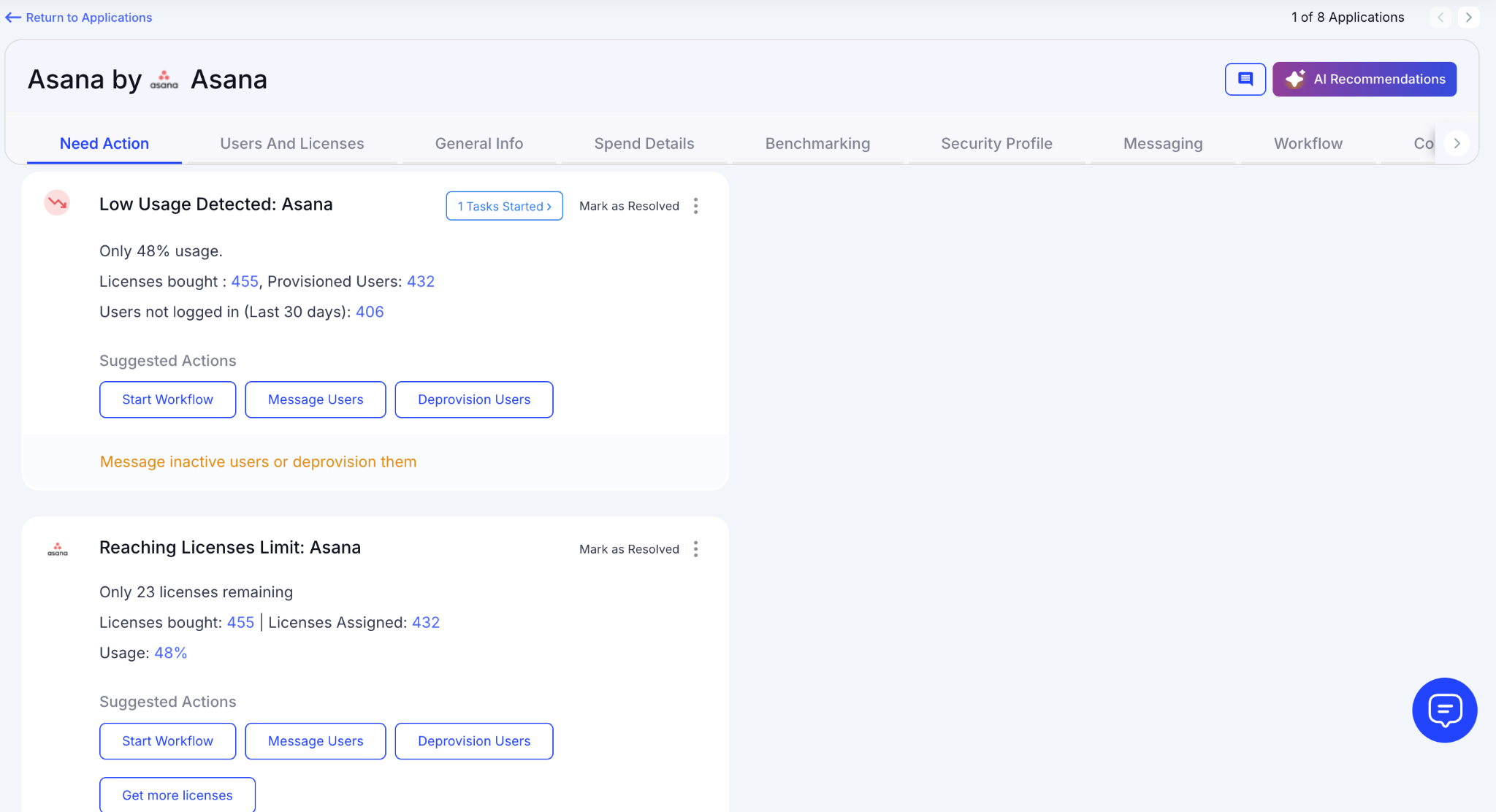
Why We Are Better
Our AI compares applications based on capabilities, not just their names. IT teams can automatically notify users, trigger workflows, or generate ITSM tickets to reclaim underused licenses and reduce risk exposure.
3. Unified License Oversight Across Teams
Handling Asana licenses distributed across various teams can quickly become overwhelming. Many organizations still rely on spreadsheets to track key applications, while manually piecing together SSO data, usage metrics, and contract details.
Current Process
Most companies only track their primary applications in spreadsheets, manually merging identity provider logs, feature usage data, and contract information. This slows updates, reduces accuracy, and creates inconsistent reporting.
Pain Points
Applications that go unmonitored drive avoidable spending, and license reassignments rarely happen at the right time. Renewal tracking often lacks consistency, leading to missed cost-saving opportunities.
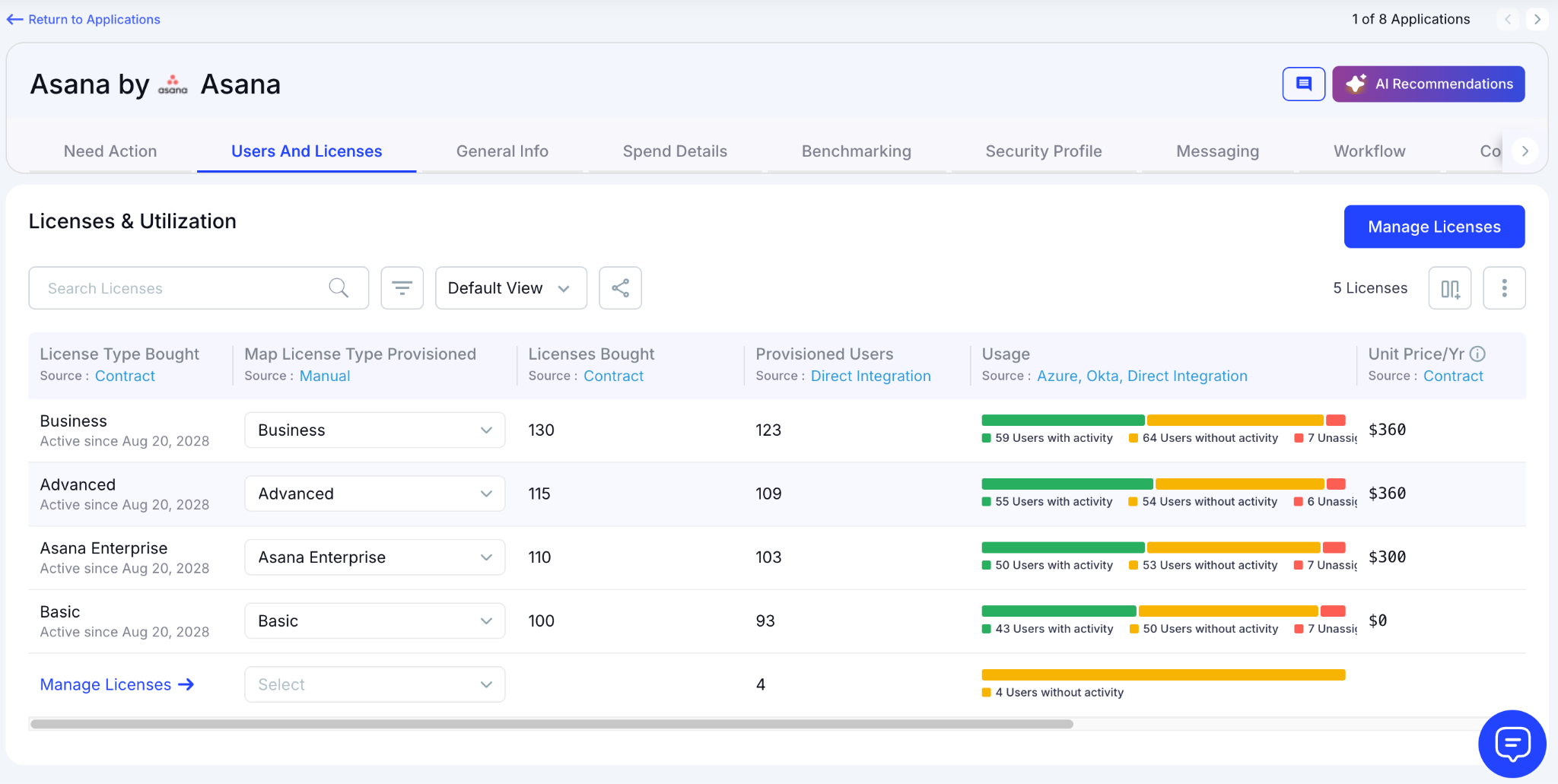
How We Do It
CloudEagle.ai brings all license management into a single, centralized platform. Nightly synchronization merges IDP records, contract data, and connector inputs, providing real-time transparency into license allocation and usage.
Why We Are Better
Automated updates match purchased licenses to active users and feature-level usage across every application. Teams can filter by license tier and instantly make informed, data-backed decisions to SaaS spend optimization and allocation.
4. Automated License Reclamation
Unused Asana licenses can quietly inflate expenses, and most IT teams lack a scalable way to reclaim them. Manually reviewing usage patterns and emailing large groups of users every week is repetitive, error-prone, and consumes valuable time.
Current Process
IT departments often send one-off emails to inactive users and update spreadsheets by hand, making the workflow slow, manual, and frequently deprioritized.
Pain Points
Inactive seats remain assigned, increasing software costs and exposing the organization to unnecessary security and access risks. Manual reclamation processes simply do not scale with growth.
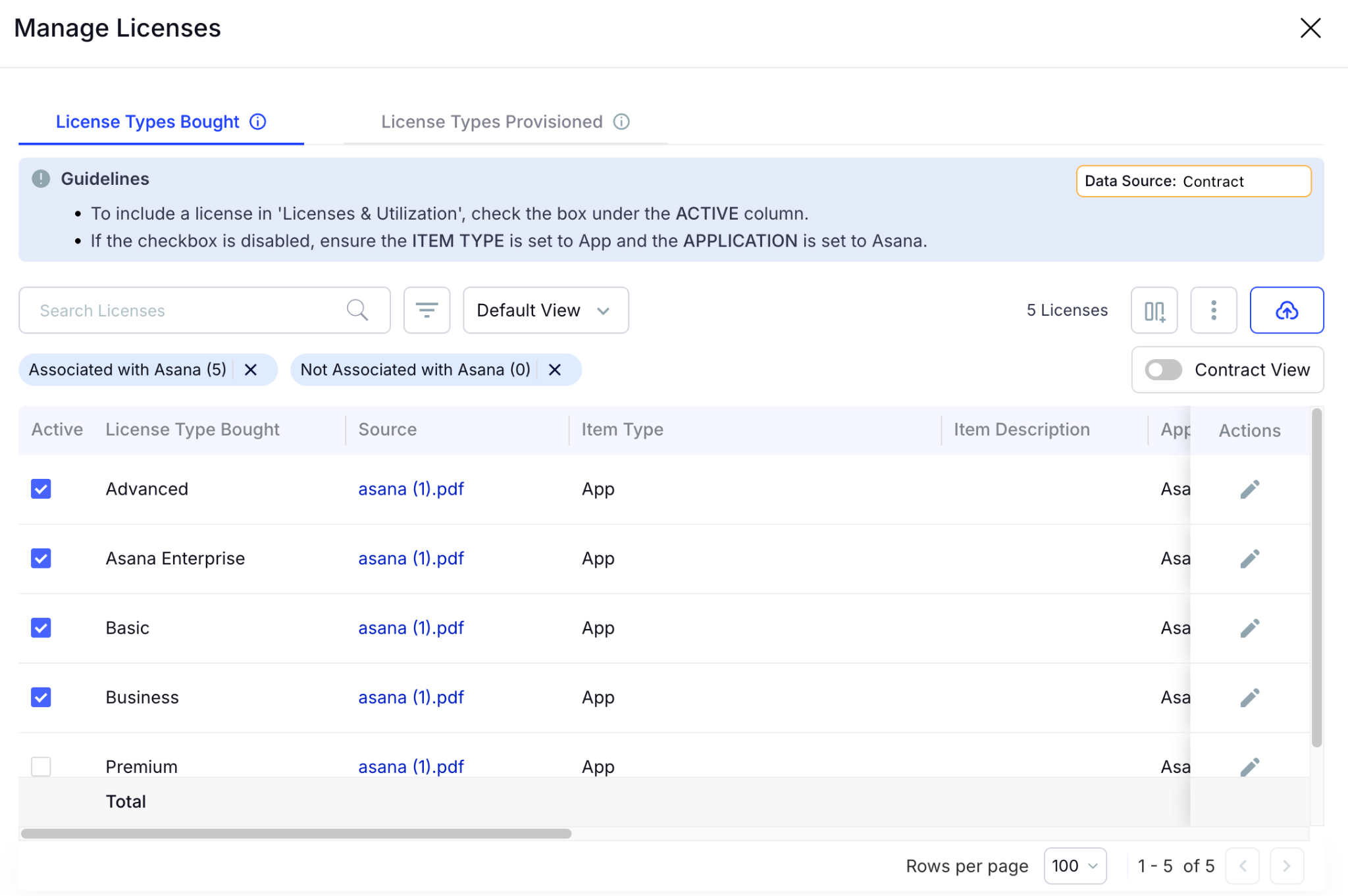
How We Do It
CloudEagle.ai automates the entire license harvesting cycle. Scheduled workflows detect inactivity, notify users, and reclaim or downgrade licenses automatically based on real usage data.
Why We Are Better
Automations can run daily or weekly through Okta or Microsoft AD. Licenses are reclaimed instantly, minimizing waste, saving operational time, and improving overall utilization efficiency.
5. License Cost Benchmarking for Smarter Renewals
CloudEagle.ai’s benchmarking capability helps organizations secure stronger pricing during renewal cycles. By comparing contract terms against current market data, enterprises can negotiate confidently and avoid unnecessary overspending.
Current Process
Procurement teams often depend on vendor-provided quotes or legacy contracts. Peer comparisons are minimal, and available pricing references rarely reflect real, up-to-date market rates.
Pain Points
Insufficient pricing insight weakens negotiation leverage, resulting in higher-than-necessary costs or less favorable renewal terms.
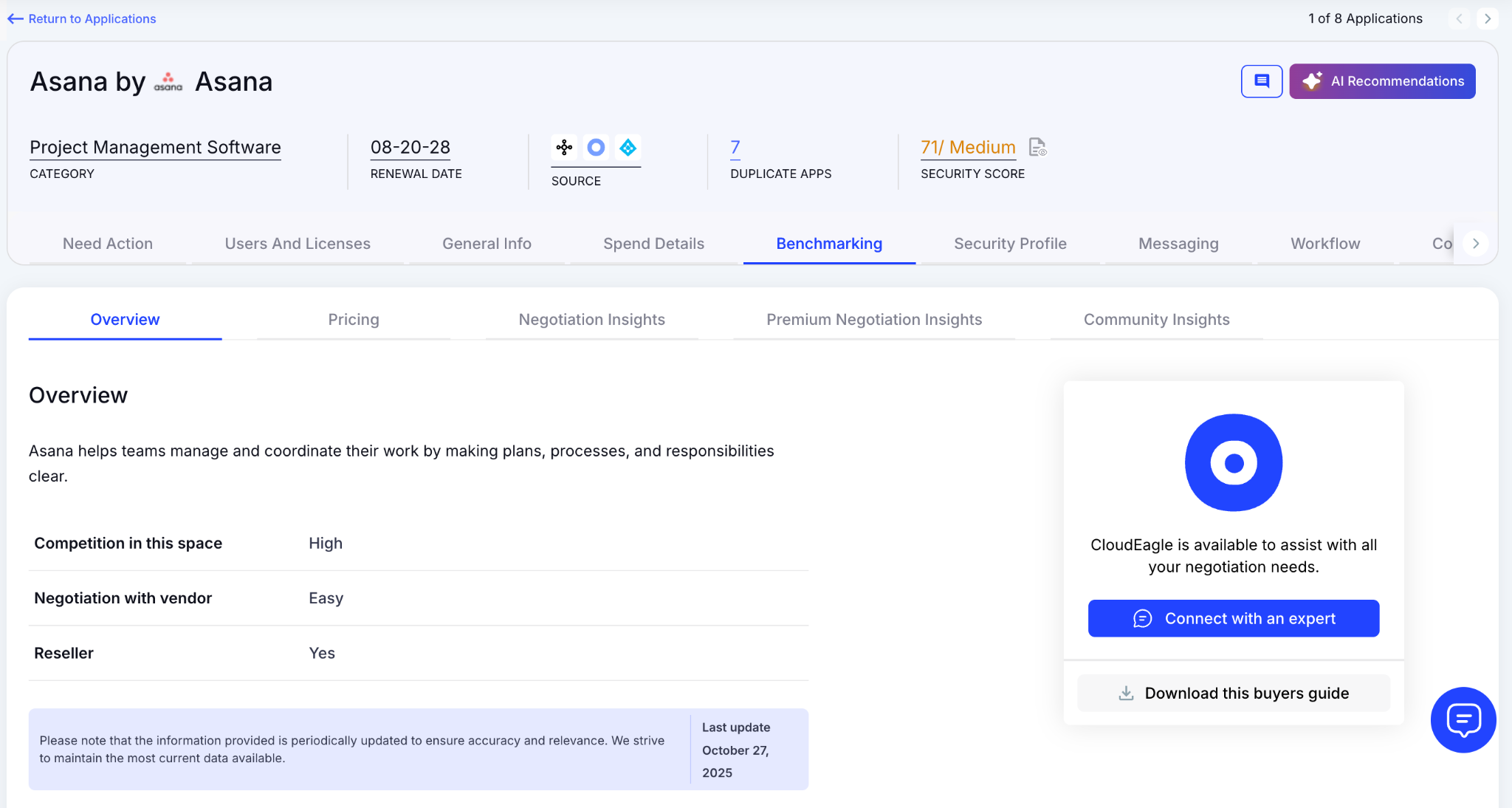
How We Do It
CloudEagle.ai delivers real-time benchmark data, historical pricing patterns, and structured Asana pricing guide to empower informed negotiation strategies supported by verifiable data.
Why We Are Better
Pricing insights are broken down by SKU, license tier, and volume, along with recommended negotiation levers, ensuring renewal outcomes align with true market value rather than vendor-driven baselines.
6. Renewal Management, Done Proactively
CloudEagle.ai automates renewal oversight by triggering workflows aligned with contract timelines. From approval routing to adjusting Asana license counts, it helps teams avoid accidental auto-renewals and keeps SaaS renewal management streamlined and predictable.
Current Process
Renewals are typically monitored through spreadsheets and long email threads. Approval cycles slow down, and auto-renewal deadlines often slip past unnoticed.
Pain Points
Missed renewal windows lead to unnecessary spend, and last-minute vendor negotiations reduce leverage to secure better pricing or adjust license counts appropriately.

How We Do It
CloudEagle.ai creates an automated renewal calendar using AI-extracted contract data or integrations with CLMs such as Ironclad, Asana, or Zip. Workflows activate 90 days before notice dates, routing tasks to finance, legal, and business stakeholders for coordinated action.
Why We Are Better
Teams receive alerts that include usage trends, pricing benchmarks, and alternative vendor considerations. Approval decisions are tracked automatically, preventing missed renewals, accidental spend commitments, and stalled negotiations.
7. Utilize Centralized Vendor Dashboards
CloudEagle.ai offers vendor-specific dashboards that consolidate all Asana subscription data into one place. Teams gain visibility into license usage, renewal timelines, and spending patterns, enabling more informed, data-backed decisions.
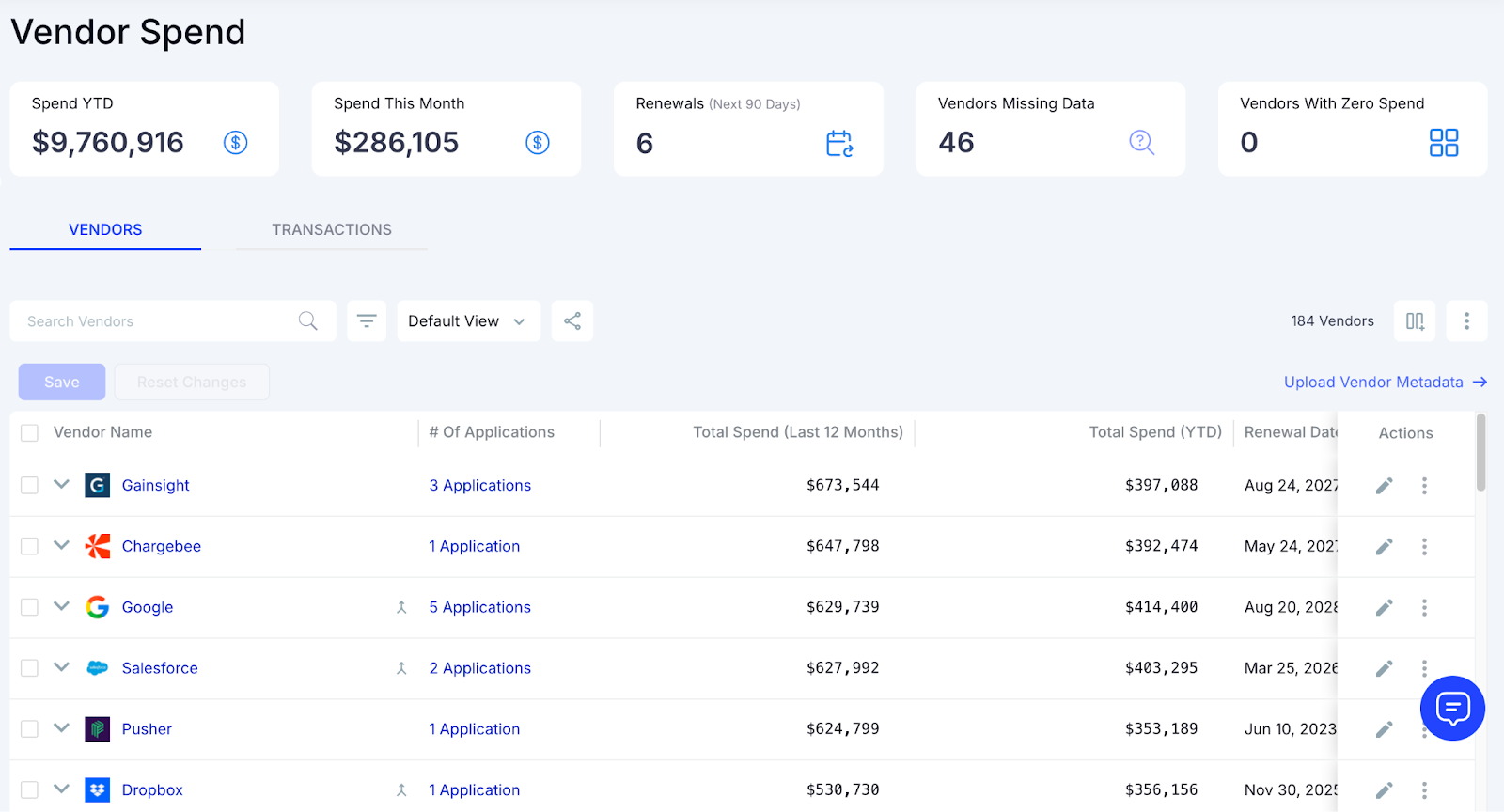
These dashboards surface overspending and identify unused licenses, making reclamation straightforward. They also reveal adoption and usage trends, allowing organizations to proactively adjust license allocations and optimize overall Asana spending.
8. Streamlined Application Access Requests
CloudEagle.ai simplifies Asana access by enabling employees to request licenses directly through the platform or via Slack, removing the need for lengthy email threads and manual coordination. Managers can review and approve these requests in real time, ensuring users get timely access.
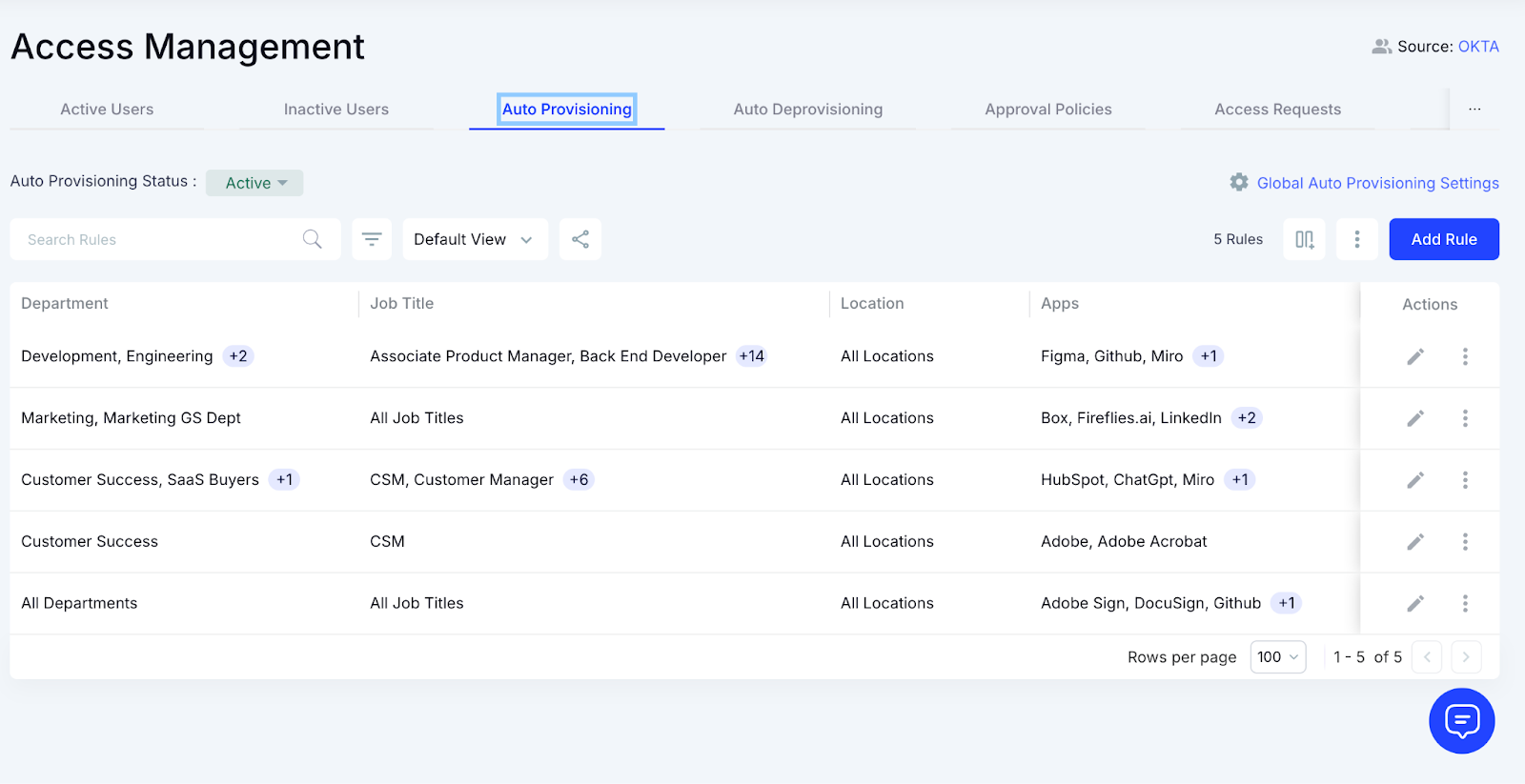
This process ensures employees receive the correct license type without unnecessary delays and eliminates approval bottlenecks. Every request is automatically logged for transparency and compliance, reducing administrative overhead while keeping access management efficient and traceable.
Outcome: Less Admin, More Work Done
Managing Asana licenses isn’t just about tracking numbers but understanding how your teams actually work, where inefficiencies hide, and how small oversights quietly drain budgets.
The good news? It doesn’t have to be this way. With the right visibility, teams can stay productive, finance can stay confident, and IT can finally breathe. CloudEagle.ai brings clarity to the chaos, letting you see which licenses are actively used, which add-ons are redundant, and where cloud cost management opportunities lie.
The result is simple: smarter license management, less wasted spend, and a smoother workflow that keeps everyone aligned.
FAQs
1. Does Asana require a license?
Yes. Asana offers free plans for small teams, but paid licenses unlock advanced features, added storage, and better project controls.
2. What is the rule of 40 in Asana?
The Rule of 40 is a project management guideline in Asana suggesting no more than 40 tasks per person for optimal productivity.
3. Is Asana free for 10 users?
Yes. Asana’s free plan supports up to 15 users, though some advanced features like timeline view or reporting require paid plans.
4. Is Asana better than Trello?
It depends on your workflow. Asana is robust for task tracking and dependencies, while Trello is simpler with boards and cards. Teams choose based on complexity needs.
5. What is cheaper than Asana?
Free tools like Trello, ClickUp (free tier), or Monday.com’s basic plan can be more cost-effective for smaller teams, though features vary.

%201.svg)









.avif)




.avif)
.avif)




.png)









